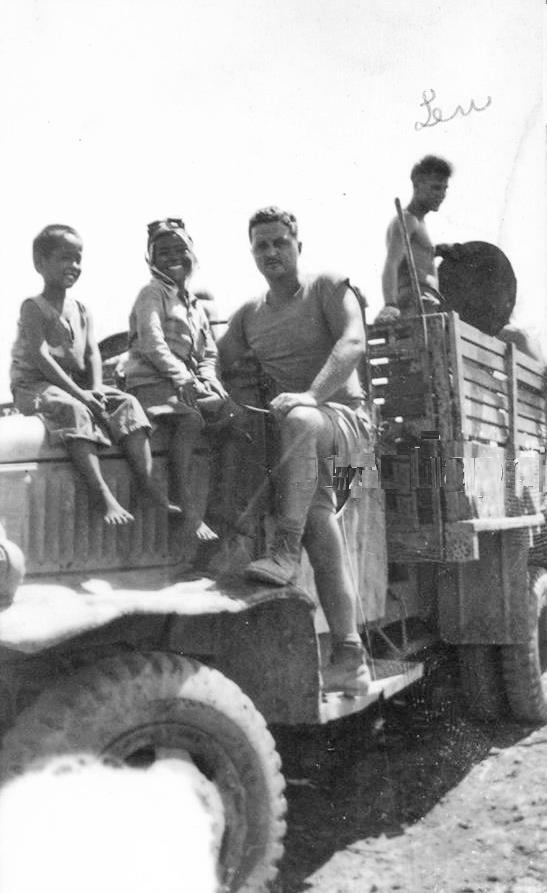
World War II Pacific Theater: Okinawa--Occupation

Figure 1.--This World ar II snapshot was found with some other Marine Corps Pacific War photographs after the Battle for Okinawa during summer 1945. Written on the back "Len Allen (in Truck) Okinawa." The boys could not have been more happy with their American buddies. Heaven knows what they experienced during the actual battle. One of the boys seems to have acquired an American flyer's headwear--no doubt his most prozed possession.
|
|
Okinawans like civilians on the Home Islands were beginning to starve because of food shortages. The Japanese military understanding that the United States needed a base close to close to the Home Islands to support an invasion, sussed out that Kyushu, the southern-most island, would be target, and that Okinawa would be the needed base. As a result, the military began cramming soldiers on the island to defend it. There was simply not enough food on the island to feed civilans and the huge garrison. The soldiers had to seize food from the civiliaans. Thus the civilans were already in terrible shape even before the Americans landed (April 1). The island became a caledon of death and statvation. The island was turned into a sea of mud and devestation. Few buildings were left standing after nearly 3 months of savage combat. The civilians not killed in the fighting or murdered by Japanese soldiers were starving. The survivors were astonished that not onky did the Americans anot torture, rape, and kill them, but actually provided food, water, and medcical care. Camps were opened to care for them while the battle was raging. Civilians flocked to them. As was always the case, the first to approach the marines and soldiers were the children, mostly the boys. This occurred quickly when the children found that there were Hershey bars and bubble gum were on offer. We see many images of boys with the American GIs and the obvious affection that developed between them. An Okinawan, Ayano Shimojo, who teaches Japanese culture to American elementary students at Camp Kinser, describes how her father lived because the U.S. military provided baby formula to his family, who was hiding in a cave. “He was one of the few babies to survive the Battle of Okinawa. My grandparents always told me not to forget about the U.S. forces’ kindness.” [Ichihashi] And the camps were kept open until the Okinawans began going home to rebuild their homes and lives. This was delayed by the act that many men died in the War. They unliked the women were pressed into service by the Japanese soldiers. So women were the main breadwinners for many families. Okinawa one island of the Ryukyu group. They were treated differently than the main Japanese Home Islands. Provisions of the 1952 Treaty formally ending the War related to the Ryukyus. Formal control of the Ryukyus was returned to Japan two decades later (1972).
CIH

Navigate the CIH World War II Pages:
[Return to Main Okinawan civilian page]
[Return to Main Okinawa page]
[Return to Main World War II: American POW page]
[Return to Main World War II Pacific campaign page]
[Return to Main Japanese World War II attrocities page]
[Return to Main World War II page]
[Biographies]
[Campaigns]
[Children]
[Countries]
[Deciding factors]
[Diplomacy]
[Geo-political crisis]
[Economics]
[Home front]
[Intelligence]
[POWs]
[Resistance]
[Race]
[Refugees]
[Technology]
[Totalitarian powers]
[Bibliographies]
[Contributions]
[FAQs]
[Images]
[Links]
[Registration]
[Tools]
[Return to Main World War II page]
[Return to Main war essay page]
[Return to CIH Home page]
Created: 8:35 PM 4/16/2019
Last updated: 8:35 PM 4/16/2019



